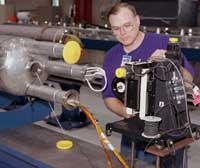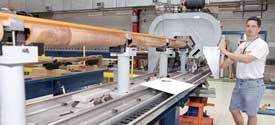 |
|
Fermilab and LHC: A Major Stakeholder by Jim Strait
The United States has a $531 million commitment to provide accelerator
and detector components for the Large Hadron Collider, which is under
construction at CERN, the European Particle Physics Laboratory in Geneva,
Switzerland, and which will begin operations later this decade. With a major
role in construction of the LHC accelerator and the CMS detector, Fermilab
will be positioned for a major role in the emergent physics when LHC begins
operating later this decade.
The US LHC Accelerator Project is led by Fermilab and executed by three
U.S. national laboratories: Fermilab, Brookhaven National Laboratory (BNL)
and Lawrence Berkeley National Laboratory (LBNL). The project focuses
on the four interaction regions (IRs) and the radio-frequency straight section
of the LHC Accelerator, testing of superconducting cable for the main LHC
magnets, and accelerator physics calculations. Fermilab, in collaboration with
LBNL and BNL, is responsible for providing CERN with integrated inner triplet
magnet systems for the IRs, which focus and bring the two proton beams into
collision at the interaction points.
The superconducting quadrupole magnets, which
provide final focusing of the LHC beams at the
interaction points, are among the most challenging
components of the machine. They must provide
a field gradient of up to 215 Tesla/meter over a
70 mm aperture. They operate at 1.9 K, under
heavy heat load due to secondary particles from
beam-beam collisions. The LHC performance
depends critically on their field quality. Following
an intensive R&D program, in which nine model
magnets and one full-scale prototype were built
and tested, the inner triplet quadrupoles for the
LHC are now in production at Fermilab. Four of
the 18 quadrupoles that Fermilab will build are
complete and two more are in production. The
first KEK- and CERN-provided magnets have
arrived at Fermilab.
The first quadrupole-corrector assembly,
consisting of two Fermilab quadrupoles with a
CERN correction coil, is being readied for insertion
into its cryostat and will be tested by the end of the
summer. Production and testing of the quadrupoles
will continue for the next two and one-half years,
and all inner triplet quadrupoles will be delivered
to CERN for installation in LHC by the end of 2004.
The US LHC Accelerator Project is more than 75
percent complete and is proceeding on schedule.
The development, construction and testing of
these very challenging magnets for LHC helps to
ensure that Fermilab and the US High Energy
Physics program remain at the cutting edge of
superconducting magnet technology. Our work
with CERN (and KEK) on the construction of the
LHC accelerator is an important step forward in
international collaboration in large science projects,
which will be crucial for the construction of future
large accelerator facilities.
The US LHC Accelerator Research Program will
further develop the US laboratoriesí capabilities,
so that the US can be the leader in the next
generation of hadron colliders; it will serve as a
vehicle for US accelerator specialists to pursue
their research; and it will train future generations
of physicists on some of the most advanced
problems in accelerator physics.
On the Web:
|

 The inner triplet systems consist of high-gradient
quadrupoles provided both by Fermilab and
KEK, the High Energy Accelerator Research
Organization in Japan, correction coils provided by
CERN, dipole magnets provided by BNL, cryogenic
feedboxes provided by LBNL, and absorbers
provided by LBNL to protect the superconducting
magnets from collision debris. In addition to
building half of the quadrupoles, Fermilab is
responsible for the integration of the Fermilab-,
KEK- and CERN-provided magnets into three
different types of quadrupole-corrector assemblies,
insertion of these into cryostats, and the final
measurements and tests of these assemblies.
The inner triplet systems consist of high-gradient
quadrupoles provided both by Fermilab and
KEK, the High Energy Accelerator Research
Organization in Japan, correction coils provided by
CERN, dipole magnets provided by BNL, cryogenic
feedboxes provided by LBNL, and absorbers
provided by LBNL to protect the superconducting
magnets from collision debris. In addition to
building half of the quadrupoles, Fermilab is
responsible for the integration of the Fermilab-,
KEK- and CERN-provided magnets into three
different types of quadrupole-corrector assemblies,
insertion of these into cryostats, and the final
measurements and tests of these assemblies. We are now preparing to extend this collaboration
into the commissioning and operational periods
of the LHC and are beginning work with CERN
to increase the luminosity of the LHC in order to
extend its scientific reach. The US LHC Accelerator
Research Program, which will be carried out
by the same three US national laboratories
under Fermilabís leadership, will focus on
the commissioning of the LHC, accelerator
physics experiments and calculations, R&D
for quadrupoles of even higher performance
than those now under construction for the inner
triplet systems, and the development of advanced
beam instrumentation and diagnostics.
We are now preparing to extend this collaboration
into the commissioning and operational periods
of the LHC and are beginning work with CERN
to increase the luminosity of the LHC in order to
extend its scientific reach. The US LHC Accelerator
Research Program, which will be carried out
by the same three US national laboratories
under Fermilabís leadership, will focus on
the commissioning of the LHC, accelerator
physics experiments and calculations, R&D
for quadrupoles of even higher performance
than those now under construction for the inner
triplet systems, and the development of advanced
beam instrumentation and diagnostics.